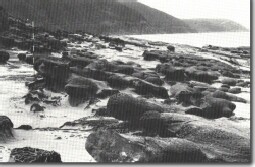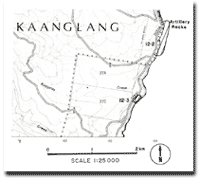12.2 Artillery Rocks
This information has been developed from the publications:
|
| Location: | 12 - 543233. Five kilometres north of Wye River |  Concretions at Artillery Rocks. |
Access: | Great Ocean Road. | |
Ownership: | Crown Land. | |
Geology/Geomorphology: | Feldspathic sandstones of the Otway Group are exposed on the shore platform and coastal cliffs. The beds dip seaward (southeast) at approximately 200 m and the coast is aligned north east - south west along the strike of the sandstone beds. Contained in a thick sequence of cross bedded sandstones are various types of concretions ranging from almost spherical (cannon ball) types to columnar, pillow and platy forms. The concretions consist of quartz, feldspar and shale fragments cemented by calcite or siderite (Gill, 1977). The calcitic concretions are more resistant to weathering and erosion than the matrix that encloses them and so they project abruptly from the rock surface. Lowering of the rock surface leaves the concretions as a capping, often elevated on pedestals of honeycomb weathered sandstone. | |
Significance: | International. This site contains easily accessible examples of several types of concretions and shows clearly the different, weathering and erosion forms referred to. The confining of the concretions to one set of sandstone beds is obvious as is their relationship to bedding, dip and strike, and jointing. The concretions demonstrate a very distinctive process in the evolution of the Otway Group sediments and detailed study of their composition, chronology and rate of weathering forms the basis of several research projects. The site contains one of the most clearly displayed clusters of concretions of this type in the world. | |
References: | Gill, E. D. (1977). "Evolution of the Otway Coast, Victoria, Australia." Proc. Roy. Soc. Vict. 89 (1&2):143-171. Gill, E. D. and McNeill (1978). "The Otway coast of Victoria, Australia." Vic. Nat. 90:12-16. | |

Outline of Artillery Rocks. Site 12.2 & 12.3


